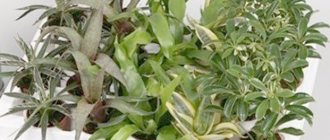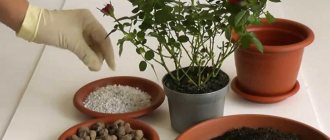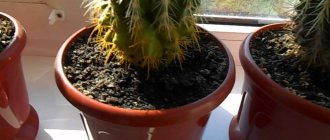How to care for a cactus mix
- 09.03.2017
I want to pay a little attention to indoor plants. Girls love to take care of flowers, indoor plants, various trees and other delights, thereby creating comfort in the house where they live. They try not only for themselves, but also for those around them, for their relatives and friends, for their other halves. Only it happens that all these efforts are in vain, and indoor plants do not grow, do not bloom, and constantly die, no matter how well they are cared for. Personally, I am very sensitive to flowers; if I buy a plant or someone gives it to me, I try to create such comfort that they can live well.
But this is not always possible to do, because either our climatic conditions do not have a beneficial effect on the plant, or, on the contrary, too much care, which begins to give the opposite reaction. Here you need a golden mean, or choosing a plant that will not bring you much trouble. What does a cactus need:
Although, if we look at the plants in a little more detail, we will see that, for example, spathiphyllium, or as it is also called “Women’s Happiness,” although it is considered an unpretentious plant, is still capricious from time to time. For example, in order for a plant to bloom constantly, it cannot be planted in a pot that is too large, otherwise it will fundamentally stop doing so. It will wait until the root system fills the entire space, and only then it will begin to bloom.
And then many people have the idea to buy cacti for home; they are also plants; they bloom very rarely, but they are not whimsical and do not require special care. But it seems to me that you are still mistaken, because any plant, even a cactus, needs its own care. You can buy a Mix cactus for home, but a legitimate question arises: how to care for a Mix cactus?
What is plant mix?
Plant Mix is a flower (the photo in the article provides an opportunity to get acquainted with an innovation in the flower industry), which is a set of several types of indoor plants, similar in care conditions, type of growth, and also in external characteristics.
As a rule, these are non-flowering houseplants of small or medium size. Flowers are planted in small pots of the same size, which are subsequently displayed in one large box, box or pallet.
Sometimes there are flower arrangements that consist of several plants of the same type, but planted in one large pot or box. This technique allows you to increase the decorative properties of the flower arrangement, thereby improving the quality of landscaping in the room.
Plant Mix is often formed from one type of indoor flowers, but differing in varietal. They can differ in the color of the foliage, the presence/absence and shape of the pattern on the leaf plate, which creates an amazing image and sophistication of the interior.
In specialized retail outlets you can find the unusual name Plant Mix, but if sellers offer one type of flower under this name, this is far from the truth, because a mix means a group or set of plants that can only be purchased in this form. Sometimes the designation 8/25 is indicated under the name, which means: 8 – plant height, 25 – pot diameter.
You can also create flower arrangements yourself, but before you start assembling the mix, you should select specimens that are at least similar in terms of keeping conditions.
Such compositions, where large flowers are present simultaneously with small representatives, are not a very good option. Large plants, as they develop, will inhibit the growth and formation of green mass in small flowers, which will subsequently lead to their death.
A mix of flowers planted in pots of the same size, with a diameter of about 10 cm or less, which are subsequently displayed in one beautifully decorated pallet, box or box, has excellent decorative properties. The largest composition is created from 25 small flower specimens, in appearance very reminiscent of a small green garden.
Other similar flower mixes:
| Mix name | Description |
| Fittonia Mix | The set is created from 6-10 types of flowers of the acanthus family with different leaf colors (red, green, lilac or white). |
| Dracaena Mix | This type of flower crop does not belong to the palm family. The set includes decorative mini-dracaenas. |
Each plant mix is endowed not only with an individual original external feature, but also has special benefits. For example, electromagnetic radiation is absorbed by plants such as cactus, succulents, dracaenas or ficuses, but to purify the air in the room from toxins and dust, it is better to purchase spathiphyllums, dieffenbachias or ivy.
How to care for mammillaria mix cactus?
We all know very well that cacti are the most unpretentious indoor plants. Only if the thought appeared in your head that you can buy it and put it on the window and safely forget about it. If you pay your attention to them, then soon they will delight you with their flowering, and let me tell you, it’s just a gorgeous sight.
How to care for Indian mix cactus?
They need bright, diffused light; the temperature in spring and summer is approximately 25 °C. But as for autumn, it’s worth lowering the temperature. Winter should bring cool temperatures to your cactus. But as for watering, in hot weather it is very necessary to cool the stem. But by winter you will need to reduce watering by half. The cactus, like other indoor plants, needs to be fed once a month when it blooms and when it grows. These are the basic rules for caring for a cactus. For example, how to care for a cactus mix with dried flowers, you can find more detailed information on our worldwide network. In the meantime, I wish you good luck and good choices. Let your indoor plant, whatever it may be, always delight you with its active growth and flowering.
How to properly care for cacti at home
Caring for a cactus is not particularly difficult. Experts note that these plants are among the most hardy and stress-resistant. Although it is still worth creating favorable conditions for their development.
Cacti are divided into two groups:
- Forest. These species grow in forest areas, so they need to create special conditions at home. Plants do not like bright sun, from which they should be shaded. Watering in the cold season is reduced to the bare minimum.
- Desert. This group of cacti is the complete opposite of the subspecies described above. Such plants die without sunlight, but at the same time, they also do not need abundant watering.
Bloom
Flowering occurs in summer. The flowers are soft yellow, medium in size, up to 6 cm in diameter. The bell flowers bloom alternately and are located at the top of the stem. Petals are narrow, oblong.
Flowering period
Echinocactus blooms only in the summer months.
Flower shapes
They have a short tomentose-pubescent floral tube. The corolla is bright lemon with multiple and narrow petals.
Type of flowers
Flowers bloom singly. They are up to 6 cm in length. They are arranged in a wreath at the top of the stem.
Changes in care during the flowering period
How to care for echinocactus during flowering? No changes need to be made to the standard content. You just need to avoid getting drops on the buds.
What to do if it doesn't bloom?
Echinocactus Gruzoni red rarely blooms at home. Plants bloom only after 20–25 years.
To stimulate flowering, you should follow the wintering regime - cool conditions and bright lighting. In summer, be sure to take the pots out into the fresh air.
How to care for a cactus so that it blooms
Often, when cacti are not properly cared for, they stop blooming. To prevent this from happening, you need to know how to care for the plant.
The first thing you should pay attention to is lighting. It varies slightly depending on the seasons.
Plants must receive light. Some species need more of it, some need less, but you can’t live without it. So, light-loving species must be placed on southern windows. If there are none, then any others will do, but it would be a good idea to take care of additional lighting so that the flower does not lack light.
Important! If the gardener notices a thinning of the crown, be sure to move the plant to a sunny place.
Summer care rules
In the summer, only forest varieties are hidden from the scorching rays of the sun, as they can burn. All others tolerate such conditions very well. In addition, during this period it is useful to take flowerpots with cacti to the balcony, loggia or courtyard. This procedure increases the plant’s resistance to various diseases and pests, and also increases the chances of excellent flowering. The only thing is to monitor drafts, or rather their absence.
Winter care rules
In winter, it is very important to maintain a minimum temperature in the room. Cacti do not like dry air, so they should be kept cool. If nothing can be done, then you can place the plant on the balcony, but at the same time make sure that the temperature does not drop below + 8°C.
Important! Cacti do not like constant rearrangement, so there is no need to move them regularly. This is especially true for the period before flowering.
What are these cacti?
Mix – several representatives of the family in one pot or pallet. Often such compositions are called Dutch sets. The succulents included in them may not be labeled, which makes care somewhat difficult. When compiling a cactus mix, it is important to take into account the species, the size of adult specimens, the distance between plants, and the preferred microclimate.
Slow-growing varieties look best, since they rarely produce children and change the created composition. It is important that succulents get along well with each other. A specimen that quickly increases in size will obscure the rest; the size of the spines and inflorescences is also important. It happens that a set includes only one variety, but the varieties are different.
The mix can be made up of:
- astrophytum;
- notocactus;
- Cereus peruviana;
- Gymnocalycium;
- ferocactus;
- Echinofossulocactus;
- Chamecereus Sylvester.
Chamecereus Sylvestra
Notocactus
Astrophytum
Cereus Peruvianus
Ferocactus
Gymnocalcium
It is not advisable to plant cacti and other succulents in the same set due to different environmental and care needs. The maintenance is especially different in winter, when representatives of the Cactus family need to greatly change the microclimate.
Cactus mix - how to care for it and how to replant it
Some gardeners believe that the cactus mix is a special species. In reality, we are talking about the most popular Dutch varieties, which are planted in the same pot and sold together. Caring for cacti at home in this case is exactly the same as for all others. The same applies to transplantation.
It is best to start the last manipulation at the end of March. In general, mid to late spring is considered the ideal time. Young plants can be treated every year, and adults - once every couple of years. In order for the cactus to be pulled out of the old pot well, it should not be watered for about a week.
After assessing the condition of the roots and making sure that everything is fine with them, you can replant the plant. To do this, you will need a pot slightly larger than the previous one, drainage, which is placed in a small layer on the bottom of the pot, and also soil. Experienced gardeners recommend pouring a small layer of fine crushed stone after the drainage layer, expanded clay, charcoal on top of it, and only after that soil. When placing the cactus in a flowerpot, you should carefully ensure that the roots are not damaged.
Important! There is no need to water the plant immediately after transplanting. The procedure is carried out after 3-4 days.
In addition, it is advisable to take the plant away from the sun.
Transplantation and propagation
All mixes are based on young plants. They usually grow very slowly. After purchase, they must be replanted, otherwise they will not live long. Although in Europe, where Plants Mixes came from, flowers are not replanted.
Before planting, determine the type of plants included in the mix. The flowers must stand for some time and acclimatize in the new place. Transplant process:
In order for the decorative appearance of the composition to remain unchanged, all pots must match the size and be the same.- The soil is selected depending on the type of plants in the set. It is enough to find out what soil composition is needed for one flower. It will also suit other copies.
- The first layer in the flowerpot is drainage. Expanded clay or crushed stone is placed at the bottom of the pot. It is better to use crushed stone, as it does not make the soil acidic.
- The second layer is filled with soil.
- Place the flower in a pot, add soil, then water it.
Plant Mix plants are propagated by cuttings. Using a sharp knife, the shoot is cut off just below the node and a cutting is formed. Its length should be from 7 to 15 cm. All leaves are removed from the bottom of the shoot and immersed in a phytohormone solution for 3-5 seconds. The cutting will immediately take root as soon as it hits the soil. It is not covered with film.
How to properly feed a plant
Properly caring for a cactus means feeding it correctly, because without obtaining useful components, the flower will not delight you with lush blooms. It is important to note that organic matter is not used. The only exceptions are epiphytic plants, which are sometimes allowed to be fed with such fertilizers in small quantities. It is best to purchase formulations that include phosphorus and calcium - much-needed elements for the plant. Today there are plenty of similar fertilizers in stores, so choosing the right one won’t be difficult.
Attention! Fertilizers are not applied in the winter season, because it is often during this period that the plant blooms.
It is also necessary to pay attention to the fact that fertilizing is used from April to September. Fertilizers are used no more than twice a month. An excess of even useful substances often leads to the death of a cactus.
Methods for watering cacti at home
Many gardeners are accustomed to the fact that plants must receive sufficient water. This is true. However, cacti at home are not watered abundantly because they do not need it. While forest species can be irrigated with some regularity, desert species are watered extremely rarely. Clean water is used for the manipulation. You can take rain or settled water. Many people irrigate with water from under a filter.
Particular attention is paid to watering by month. The fact is that an incorrectly performed procedure can lead to the fact that the gardener will not be able to see his favorite plant blooming, because it will refuse to throw away even the buds.
Therefore, in winter, which for plants occurs at the end of November - beginning of March, adult specimens are watered once every 4 weeks, and young ones - once every 20 days. At the same time, under no circumstances should you flood the cactus; it does not need excess moisture. When buds appear on the flower, the frequency of watering can be increased slightly, but this does not apply to cereus species; at this stage they are only sprayed with warm water.
Important! If you fill a cactus at the budding stage, you will see “babies” instead of flowers.
It is better to water the presented plants rarely or not to water them at all for a month than to overwater them and cause the flower to rot.
With the arrival of spring, all living things begin to “wake up”. The same applies to cacti. The temperature outside the window gradually increases, and with it the amount of watering needs to be increased. Gardeners advise carrying out the manipulation 2 times a month in March, increasing watering to three times a month in April, and carrying out the procedure every 5-7 days in May. Spray the cactus no more than once every 15-20 days. Such care at home will enable the plant to prepare for the hot summer. At this moment, watering is carried out based on the condition of the substrate. If the flower pot is located outside, where the daily temperature does not drop below +33..+35 °C, then you can safely carry out the manipulation every other day. On rainy days, of course, water the cactus less often.
The conditions for keeping cacti in the autumn must be special, because, starting from this moment, the flower can already be prepared for the upcoming dormant period. At this moment, you need to take care of lowering the temperature in the room and reducing the watering schedule. For example, if in September it is still possible to carry out the procedure every 7-10 days, then with the onset of October, watering is carried out less frequently - once every 14-16 days. As for watering in winter, this has already been said.
Description of the plant
Echinocactus Gruzoni (Gruzona, Grusona) grows in the wild in Central Mexico. Named after the German scientist Hermann Gruson, who collected cacti.
Echinocacti - cacti with spherical stems
Echinocacti are cacti with spherical stems (they are also called hedgehog cacti). They grow very slowly, after 5 years they form 1–2 areoles per year. They can live for several centuries.
Echinocactus Gruzoni has other names - “golden barrel”, “golden ball”, “golden ball”, “mother-in-law’s pillow”, “mother-in-law’s chair”.
Gruzoni is the most common of the echinocacti. An adult plant looks like a barrel, about 1 meter wide and more than 1 m high (in room conditions - up to 40 cm in diameter). Does not bush.
Many people mistakenly believe that the Texas Echinocactus is a subspecies of Gruzoni, when in fact it is the same variety of Echinocactus
The color of the stem is dark green. It forms about 30 ribs; pubescent areoles with powerful, slightly curved white or yellowish spines are tightly placed on them.
In nature and greenhouses, plants bloom that are older than 20 years, with a stem width of 40 cm. The flowers are tubular, yellow, up to 5 cm in diameter and 7 cm in length, arranged in a wreath at the top. The flowers have many lanceolate petals with elongated tips of a yellowish-brown color. At home they bloom in the rarest cases.
In flower shops you can find Gruzoni with multi-colored needles. This is not a natural process, but the result of the action of dyes.
Table: conditions for keeping echinocactus
| Season | Lighting | Humidity | Temperature |
| Spring Summer | Bright light, not afraid of direct rays. South windows of the ventilated room. In summer it is good to take it out into the garden or onto the balcony. | In hot weather, spraying is possible; this imitates dew in natural conditions. | 18–23°C At temperatures above 30°C, growth slows down. A period of rest may begin. |
| Autumn winter | On the windowsill, but not near the radiator. At the beginning of spring, gradually accustom them to direct sunlight (to avoid burns). | Does not require additional spraying. | 10–12оС |
Video: what echinocactus looks like
What you need to know about cactus pests and diseases
Caring for a cactus is not particularly difficult, so you can’t run into problems with it. If you keep the flower in the conditions that were mentioned, then nothing bad will happen.
Typically, a gardener is faced with root rot, which occurs due to excess moisture. At the initial stage, the issue can be resolved. To do this, you need to remove the plant from the pot, carefully shake off the soil, remove all rotten roots, and treat the remaining ones with some kind of antiseptic. After this, the plant is transplanted into a new pot with new soil. Watering is carried out only when it is noticed that the cactus has begun to grow.
Important! In order to prevent diseases from making themselves felt, you should properly care for cacti at home, listening to wise advice.
As for pests, they rarely make themselves known. Typically, the plant may have scale insects, aphids, spider mites or mealybugs. They should be controlled with insecticides. Although experts note that such “guests” live only in apartments where the air is too dry or, on the contrary, humid.
Diseases and pests
Diseases
Echinocactus Gruzoni can only get sick if its root system is overcooled or due to excessive watering. The bush may die due to root rot. In order to avoid hypothermia of the root system during a cool winter, it is recommended to place the flower pot with a cactus on thick cardboard or folded newspaper.
Pests
Most often, pests such as cactus mites, scale insects and scale insects settle on echinocactus.
Shchitovka
If scale insects have settled on the plant, you can tell by the brown plaques on the surface of the stem. To make sure that the appearance of these plaques is associated precisely with the occupation of the cactus by a pest, you need to pick it off with a sharp object. If under the plaque you see whole, undecayed tissue, it means it’s a scale insect. If there are a lot of pests, they will cover the surface of the plant with sticky secretions. You can cope without pesticides only if there are few scale insects on the bush. Take a cotton swab, moisten it with alcohol and wipe it on the places where the pests are located. If such treatment is impossible due to thorns or a lot of pests, then the cactus is sprayed with a solution of Confidor or Aktara.
Cactus mite
The body of the cactus mite is colored brownish-red, and it does not produce webs, which distinguishes it from the spider mite. If this pest settles on a plant, you will see pale brown spots on its stem. It is impossible to see the pest with the naked eye, since it is very small (from 0.1 to 0.3 millimeters). To get rid of a tick, water the root zone and substrate, and also spray the bush itself with a solution of an acaricidal drug, for example: Oberon, Actellika, etc. You will need 2 treatments, which are carried out with a break of 7 days.
Chervetsy
First, scale insects settle on the root system and in the root zone of the plant. Over time, they spread over the surface of the stem. You can see them in the areolas and between the ribs. Outwardly, such pests are similar to a whitish coating, which looks like fine salt or flour. To save the cactus, treat with Confidor or Aktara solution, and pour the soil mixture with it. The pesticide absorbed by the root system will make the entire bush inedible for this pest. If you find scale insects on the root system or root collar, you will need to transplant the bush into a fresh substrate. Pull the affected bush out of the old pot, remove all the soil mixture from its roots and lower them, along with the root collar, into hot water (about 50 degrees) for a quarter of an hour. Instead, the root system can be immersed in the Actellik solution, but it is only kept there for a short time. Plant the bush in a new pot or in a sterilized old one. Pour a couple of packs of crushed activated carbon into the fresh soil mixture, which is necessary for disinfection.
If you have several cacti, then after pests are detected on one of them, all specimens are treated.
Cactus mix: types and features of care
Cactus mix is a composition of small cactus plants grown in one pallet. Many lovers of these plants are attracted to this form of cultivation. However, not everyone knows how to choose the right cacti for a set, how to care for such plants, and how to propagate these representatives of the flora. Before you get such a green decoration for your home, you need to familiarize yourself with the theory of care, as well as purchase the necessary equipment. Information on all of the above issues is presented in this article.
Peculiarities
Like any indoor plant, the cactus mix has its own unique characteristics. There are several main points.
- To grow a “set” of plants, you need to select varieties of cacti that get along well with each other. Often Dutch varieties are combined in the mix.
- The rule for maintaining such a mini-greenhouse is also the same size of all its components. Otherwise, taller cacti will shade others, throwing off the balance.
- Each cactus should be placed in a separate container (mostly small pots are used for this). It is advisable that they be made of plastic, which is mainly suitable for young cacti, or clay. The round shape of the vessels is preferable, since it is thanks to it that air circulation in the soil improves. All containers with plants are placed close to each other in several rows, thereby creating a single composition.
- Combining cactus varieties with other types of succulents in the same mix is not advisable. Despite the same size of plants, their climate and care needs can vary greatly, which subsequently complicates the process of growth and development of these representatives of the flora.
- Unlike a simple cactus, mixes look very unusual and creative, since the components harmoniously complement each other and form different compositions. This green decor fits well into some interior concepts, for example, eco-style.
- You can expect plants to bloom only with proper care. For the most part, cacti bloom infrequently and only under ideal conditions.
- The most suitable place to place a small greenhouse would be a window sill, since it receives a lot of the light that cacti need. However, you should ensure that plants are not located too close to heating radiators.
Varieties
The group of cacti that make up the composition of a mini-greenhouse may include various types of mini-succulents, each of which, in addition to general characteristics, has individual characteristics. The most popular are several types.
- Gymnocalycium Mikhanovich is a cactus with an unusually shaped colored stem with several sharp edges. The color of this small plant can be rich green, brown or even whitish. Such a plant is grafted onto a green cactus rootstock.
- Espostoa is an unusual species of cactus plant. Its main feature is soft long white hairs instead of the usual prickly needles. Such an instance will successfully dilute the overall composition.
- Red ferocactus is another type of cactus that is suitable for a mix and attracts attention. The peculiarity of the plant is its rather long and bright needles. In this case, the size of the stem can be no more than ten centimeters. It is colored red, which is quite unusual for this family of plants. The cactus has massive ribs, as well as a not very developed rhizome, growing mainly in breadth.
- Stenocactus is an interesting variety, the distinctive feature of which is the presence of many folds that form the ribs of the stem.
- Gymnocalycium Dams is a cactus that begins to bloom at a fairly early age. It is characterized by light, large buds. The plant does not require care.
- The small-flowered cactus has a flattened stem of small height (about 7 centimeters). The ribs of this representative of the flora are low. It blooms beautifully. The white flowers have a red tint at the base.
- Andre has an unusual structure. The dark green stem has pressed spines, and when the plant blooms, bushes with many bright yellow flowers are formed.
Thus, with the help of a variety of cacti of unique shapes, you can create a truly atypical mini-greenhouse for every taste. The main thing is to properly care for each variety and follow general recommendations for keeping cacti.
Description and photo
Gymnocalycium mix is a mixture of several species that coexist perfectly in one container. Gymnocalicium is native to South America, more specifically Argentina and Brazil.
The original home cactus does not require special care , which is why many gardeners grow it. Experienced gardeners recommend planting several types of plants together. They combine perfectly with each other, resulting in a beautiful composition of small cacti.
Gymnocalycium Michanovich
It has a greenish stem with a brown or red tint, no more than 5-6 cm in height. The flower is large, funnel-shaped, and comes in red, white, orange or yellow colors.
Japanese
On the basis of the previous species, breeders developed the Japanese species (Friedrich), which does not have chlorophyll and is interesting not even for its flowers, but primarily for its bright color of the stem. To ensure vital activity, such cacti are grafted onto a rootstock. The stem is spherical and produces pink and purple flowers.
Andre
It has an unusual color and a very interesting appearance. The stem is dark green, the flowers are collected in a bush and have a light yellow color.
Reductum
The surface of the plant is covered with straight spines, the flowers are white or beige.
To prevent plants from interfering with each other during growth, they are planted at a distance of 2 cm from each other. As the cacti grow, they are transplanted into a larger pot than the previous one.
Nuances of cultivation
The cactus mix is not that difficult to care for at home. To do this, it is enough to remember a few basic rules and promptly carry out procedures that provide comfort to the plants.
- Pay attention to the soil. You can buy a ready-made composition for cacti, or you can make the necessary soil mixture yourself using components such as leaf soil, peat, river sand, and charcoal powder. Remember that all components must be disinfected using steam or heat treatment.
- When the active stage of the growing season begins , it is necessary to supply the soil composition with additional fertilizers, which are usually added to the soil along with moisture during the irrigation process. They are sold ready-made and are designed specifically for succulents and members of the cactus family. Remember that the application of nutrients should be stopped in the fall, as well as 30 days before the expected flowering.
- To prevent discomfort for plants growing in the neighborhood , it is necessary to prune the shoots in a timely manner. This must be done carefully, so it is recommended to use only sharp blades or knives.
- As plants grow, they need to be replanted in a timely manner. The signal to start this procedure will be the growth of the root system to such an extent that it fills the entire pot. The new pot should be slightly larger than the previous one. During the replanting process, do not forget to make a drainage layer 1 to 3 centimeters thick, depending on the height of the container. After completing the procedure, do not add moisture to the soil for several days, and fertilizer for 1-2 months.
- Throughout the year, it is advisable to vary the temperature in which the mix stays. In summer, temperatures from +22 to +27 degrees Celsius are acceptable. In autumn, the temperature level should be lowered to +16 degrees. In winter it should be approximately 10-12 degrees Celsius. Remember that the minimum permissible temperature is 7 degrees above zero.
- Watering is a very important procedure for a mini-greenhouse, which is also regulated by the current season. In summer, it is necessary to add more moisture, so the recommended frequency of watering is every other day. It's better to do this in the morning. The water should be warm (about 30-40 degrees).
If cacti are kept warm in winter, then water should be added to the soil 1-2 times a month. If the plant is located in a room with a lower temperature, then in the winter season it is possible not to water at all. Cacti tolerate this quite well. With the onset of spring, soil moisture should be gradually restored.
- During the growth period of cacti, increased humidity will be useful. You can create it by covering the plants for an hour and a half after watering. As these flora representatives grow, increase the frequency of ventilation of the mini-greenhouse.
- Despite the fact that most cacti need a lot of light, it is desirable that it be diffused. Therefore, during the midday sun, slightly shade the mini-greenhouse so that the rays shine softly.
Care requirements
When compiling a mix, flowers are selected that can develop in the same temperature range. In summer, at temperatures from + 18 to + 23 degrees, and in winter - from + 15 degrees. Plant the plants in well-lit places, but without direct sunlight. As well as care requirements include fertilizing and watering:
- Soil and fertilizer. Selecting soil and fertilizer for plants will not be difficult, since the set includes flowers of the same type. Organic and mineral substances are used as fertilizers. Fertilizer is applied in spring and summer, 2 times a month.
- Summer watering. Each flower in a set may need a different amount of water. Therefore, watering is carried out after the top layer of soil has dried. Use clean, settled water. It must be remembered that excess moisture is detrimental to any plants, so everything should be in moderation. The flowers are additionally moistened with a spray bottle. This will clear them of dust, and the moisture-loving specimens included in the set will receive additional water.
- Winter watering. In winter, a dormant period begins, so watering is halved. At this time, the plants gain strength, and in the spring they begin to actively grow and bloom. In addition, in winter moisture evaporates much more slowly than in summer.
If one of the specimens gets sick or is attacked by pests, neighboring flowers may immediately become infected. Black rot, thrips and scale insects are easy to kill with insecticides. The room in which the flower is processed should be well ventilated. For safety, the procedure is carried out with gloves. When attacked by aphids, all plants except dwarf palms will become infected. Insects do not like these plant varieties. Infected specimens are sprayed with a soap solution - 10 grams of tar or laundry soap are dissolved in 1 liter of water. The most disease-resistant plants are those with smooth and hard leaves.
Reproduction
Mixed cacti can be propagated using cut “babies” that have aerial roots. After cutting the shoots, you need to dry the cut area for several days so that it is covered with a thin layer of skin. After this you need to make a moist soil mixture. It consists of two components: sand and peat. Root the shoot in the soil without deepening it too much. Place a support nearby (a small wooden stick or stone). Cover the container with a plastic bag on top to create greenhouse conditions.
Diseases
If you do not take care of your cactus mix in a timely manner, there will be a risk of serious illnesses.
- If wintering conditions are not met, the stems of cacti become bent and the size of the spines decreases.
- If the plants do not get enough light, it can lead to etiolation, which causes the cactus stem to become elongated and the green color to discolor.
- If you suddenly lower the temperature the mix is in, the stems of the cacti may shrink. Therefore, carry out its gradual reduction before wintering.
- The growth of buds may stop if cold moisture is added to the soil after a long break. The buds turn into dried flowers and fall off.
- Control sunlight and fertilizer levels to prevent brown spots from forming on cacti.
Thus, the cactus mix will be a wonderful addition to your home and will delight the eye every day if you carefully care for each of the plants and pay attention to changes associated with the flowering period and seasons.
See below for more details.











